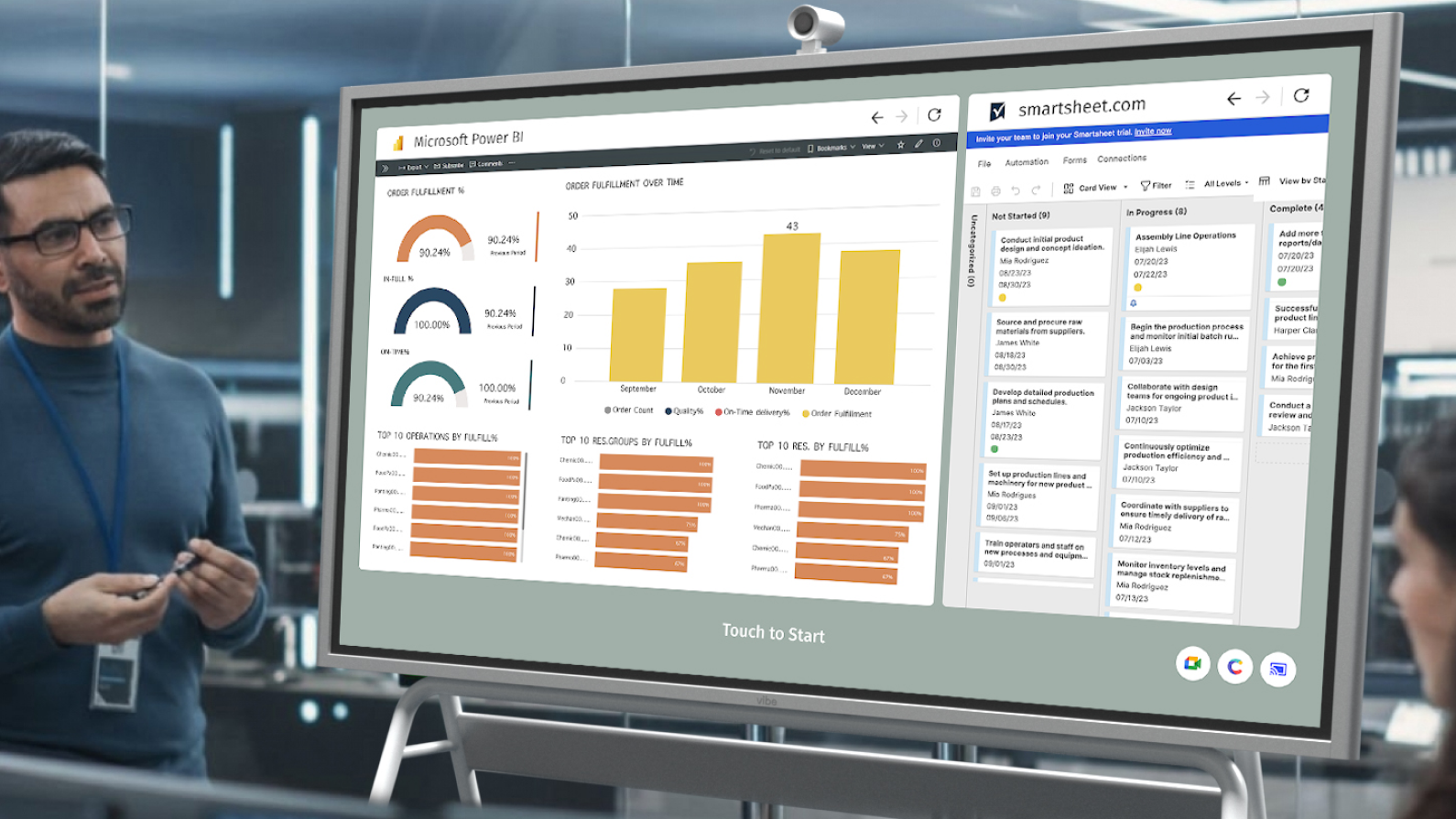Ever find yourself juggling three Slack conversations, frantically editing a Google Doc while someone else is typing in real-time, and trying to follow a Zoom meeting where half the participants are on mute with their cameras off? Sound all too familiar?

This isn’t just the reality of modern work—it’s the new frontier of online collaboration. When done right, online collaboration transforms scattered teams into synchronized powerhouses that outperform traditional in-person groups. When done wrong, it becomes a productivity nightmare of miscommunication and digital chaos. The difference lies in understanding not just the tools, but how they reshape team dynamics for seamless virtual teamwork. Throughout this guide, you’ll discover how to turn your current digital juggling act into effortless collaboration. Get actionable strategies to streamline your workflow, essential features that actually matter when choosing tools, our top recommended platforms, and expert solutions to the collaboration challenges keeping your team from reaching its full potential.
- Effective online collaboration requires strategically combining synchronous and asynchronous methods based on your team’s specific goals and time zones.
- The most successful virtual teams establish clear communication protocols, centralized information hubs, and regular feedback loops to prevent digital chaos.
- MagnYour collaboration tools should prioritize real-time co-editing, seamless integrations, and robust security rather than flashy features that don’t support actual workflow needs.is commodo habitasse sociosqu quisque placerat semper.
- Well-implemented online collaboration delivers measurable ROI through increased productivity, reduced operational costs, and accelerated innovation cycles.
What is Online Collaboration?
Online collaboration is teamwork conducted through digital platforms, allowing people to pursue shared work goals online from anywhere. Using tools such as Slack for messaging, Google Docs for co-authoring, Zoom for video meetings, and Trello for task tracking, colleagues can chat, meet, edit files, assign tasks, and monitor progress in one connected workflow—functioning as seamlessly as if they were in the same room.
Let’s break down the different types so you know exactly how each may fit into your daily workflow.
Types of Online Collaboration
There are several core types of online collaboration, each serving distinct purposes for team communication and productivity. Understanding these helps you match collaboration strategies to your team’s needs and project goals.
-
Synchronous Collaboration: Real-time interactions such as virtual meetings, live chats, or joint document editing (e.g., Zoom, Google Docs). This style enhances instant feedback and collective decision-making.
-
Asynchronous Collaboration: Team members contribute on their own schedules using emails, forums, or shared documents. This supports flexibility, accommodates time zones, and helps reduce the risk of clashing schedules.
-
Project Management Collaboration: Platforms like Trello or Asana allow teams to assign tasks, track progress, and manage deadlines from a single view. It’s ideal for improving client engagement and ensuring discovery calls translate into actionable next steps.
-
Document Collaboration: Multiple users can edit, comment, and share documents or files simultaneously in tools like Google Drive or Microsoft 365. This streamlines document approvals and supports efficient microlearning modules.
-
Video Collaboration: Leverages face-to-face communication and screen sharing for training, client relationship management, and immersive sales presentations (e.g., Zoom, Microsoft Teams).
-
AI and Automation Collaboration: Intelligent tools that streamline collaborative workflows through automated task assignment, meeting transcription, content summarization, and smart scheduling (e.g., Notion AI, Slack AI, Calendly). This reduces manual coordination work and helps teams focus on high-value creative and strategic tasks.
-
Digital Whiteboarding Collaboration: Teams use online whiteboarding tools like Miro, Lucidspark, or Vibe Canvas to visually brainstorm ideas, organize workflows, and create diagrams together in real time. Whiteboarding sessions energize the team, making collaboration more creative and inclusive.
Benefits of Online Collaboration
Unlocking the full power of online collaboration delivers several key advantages you won’t want to miss—each contributing to healthier, more adaptable organizations. Here’s why embracing these benefits will set your teams apart.
Boosted Productivity and Efficiency
Online collaboration enables teams to work faster and smarter. By centralizing communication and task management, it eliminates the back-and-forth associated with traditional workflows. Teams can share updates, access resources instantly, and complete projects without delay. Research shows that using online collaboration tools increases productivity by 30%, with collaborative workers demonstrating over 50% higher effectiveness in task completion compared to those who work independently. [1] This agility means important decisions are made quickly, fueling continuous improvement and tangible results.
Improved Communication
Online collaboration transforms how teams communicate by breaking down traditional barriers and silos. Digital tools create transparent, centralized channels where all team members can access the same information simultaneously, eliminating the confusion of scattered email threads and version control issues. Real-time messaging, shared project boards, and virtual brainstorming sessions ensure that updates, questions, and feedback reach the right people instantly. This structured approach to communication reduces misunderstandings, accelerates decision-making, and keeps distributed teams aligned on goals and progress.
Centralized Information and Resources
A single collaborative workspace puts all essential files, updates, and discussions in one accessible location. This prevents critical knowledge from being siloed or lost in fragmented email threads. With everything documented, team members know exactly where to look for key resources they need to work their best—a huge advantage in dynamic business environments.
Saved Time and Reduced Costs
Online collaboration tools significantly reduce reliance on in-person meetings, travel, and physical office resources. Remote and hybrid teams can collaborate anytime, anywhere, which not only cuts operational costs and reduces wasted work hours. The end result: more value with less overhead. In fact, Global Workplace Analytics estimates that employers save an average of US $11,000 per half-time remote employee each year through reduced real-estate needs, lower absenteeism, and higher productivity [2].
Enhanced Innovation
Collaboration platforms bring together diverse perspectives, enabling creative problem-solving and innovation. Digital whiteboards and brainstorming tools help generate fresh ideas and fine-tune tactics—increasing the chance of breakthrough moments that keep your business ahead of the curve.
6 Tips for Effective Online Collaboration
To unlock all these benefits, teams must be strategic in how they implement collaboration systems. Here’s how you can set up your tactics and habits for successful online collaboration:
1. Coordinate Schedules and Availability
Establish clear meeting times and check-ins—taking different time zones and work styles into account. Using shared calendars or scheduling tools ensures everyone is included, reducing project delays and team friction.
What it looks like: Manage 3+ employee time zones by rotating meeting times weekly, use scheduling tools like Calendly or When2meet for async coordination, always include buffer time (5-10 minutes) for tech setup and troubleshooting, and establish "core overlap hours" when all team members are expected to be available.
2. Set Clear Agendas and Goals
An agenda for each virtual meeting or project sprint helps participants know what to expect and how to prepare. Defining specific objectives guides discussion, streamlines follow-ups, and keeps projects moving forward.
What it looks like: Send agendas 24-48 hours in advance with time allocations for each topic, include pre-work assignments or required reading, use the "PREP" format (Purpose, Results, Engagement, Process), and end every meeting with clear next steps and ownership assignments.
3. Encourage Participation and Inclusion
Foster a culture where every team member feels empowered to contribute, whether in chat threads, calls, or collaborative documents. Inclusive practices reduce silos and support the emergence of new leaders and ideas.
What it looks like: Use the "round-robin" technique to ensure everyone speaks, implement anonymous suggestion tools like Mentimeter for sensitive topics, create smaller breakout rooms (3-4 people max) for shy participants, and establish "no interruption" ground rules during brainstorming sessions.

4. Establish Single Source of Truth
Centralize project plans, discussions, and resources in one location. This ensures everyone accesses the latest information and avoids confusion over document versions.
What it looks like: Choose one primary platform (Notion, SharePoint, or Google Workspace) for all project documentation, implement clear file naming conventions with dates and version numbers, create standardized folder structures across all projects, and designate one person as the "information curator" for each major initiative.
5. Regular Check-Ins and Feedback
Frequent touchpoints—whether brief standups or feedback surveys—address bottlenecks, encourage transparency, and build trust within the team. Consistent reviews are key for continuous improvement and sustained success.
What it looks like: Schedule 15-minute daily standups using the "3 questions" format (what you did, what you’re doing, what’s blocking you), conduct weekly "pulse surveys" with 2-3 quick questions, implement monthly retrospectives with "Start, Stop, Continue" frameworks, and create safe spaces for honest feedback through anonymous channels.
6. Leverage the Right Tools
Select collaboration tools that align with your team’s workflows—for example, using whiteboarding apps to drive creativity or project management platforms to track progress. The right technology supports teams to perform at their best.
What it looks like: Audit your current tool stack and eliminate redundancies, pilot new tools with small teams before company-wide rollouts, ensure all chosen platforms integrate with each other to prevent data silos, provide mandatory training sessions for any new collaboration technology, and establish "tool champions" who become internal experts and support resources.
Features to Look for in Online Collaboration Tools
Choosing the right software is critical for smooth communication and workflow integration. Prioritize these features when assessing online collaboration solutions:
-
Real-Time Messaging & Communication
Instant chat, commenting, and notifications keep team members connected and responsive throughout the workday. These features enable quick decision-making and foster a culture of open, transparent team communication.
-
File Sharing & Cloud Storage
Secure sharing and centralized storage allow users to upload, access, and collaborate on documents, images, and media from any device. Reliable cloud storage ensures that content is protected and readily accessible to everyone who needs it.
-
Task & Project Management
Organization tools help assign responsibilities, set deadlines, and monitor project progress in a single platform. This streamlines workflows by ensuring all team members are aligned, accountable, and aware of priorities.
 Vibe Board displaying up-to-date project progress, allowing drag-and-drop updates, calendar views, and team alignment.
Vibe Board displaying up-to-date project progress, allowing drag-and-drop updates, calendar views, and team alignment.-
Video Conferencing & Screen Sharing
Video calls and screen sharing support engaging virtual meetings and collaborative presentations, making remote interactions as productive as in-person sessions. These tools facilitate clearer communication, knowledge transfer, and real-time collaboration across locations.
-
Work Co-Editing
Multiple users can simultaneously edit documents, spreadsheets, or visual boards, allowing seamless teamwork and faster completion of tasks. Real-time co-editing minimizes version control issues and keeps collaboration moving forward without bottlenecks.
-
Integration Capabilities
Connectivity with other essential tools—like calendars, CRM systems, and productivity apps—enables seamless information flow and reduces the need to switch between different platforms. Deep integrations enhance efficiency and help maintain a consistent workflow across your organization.
-
Security & Access Controls
Robust encryption and customizable permissions protect sensitive data and ensure that only authorized users can access particular files or functions. These controls are essential for maintaining compliance with industry standards and ensuring data privacy.
-
Ease of Use & Customizability
A user-friendly interface shortens the learning curve and encourages quick adoption across teams of any size. Customizable dashboards and workflows let you tailor the platform to your unique processes and preferences.
 The Vibe Board featuring tools for smooth online collaboration and customizable use.
The Vibe Board featuring tools for smooth online collaboration and customizable use.-
Notifications, Calendar Views & Reminders
Automated alerts notify users of upcoming deadlines, meetings, or important updates—helping teams stay organized and meet goals. Integrated calendar views provide a clear overview of tasks and schedules, making it easier to manage time and resources efficiently.
Top Online Collaboration Tools
Need help finding proven platforms that work at enabling effective remote or hybrid collaboration? Explore the strengths of today’s leading platforms. Each tool listed below accelerates different aspects of online collaboration, helping you build an agile and resilient team.
|
Tool |
Expanded Key Strengths |
|
Real-time messaging with organized channels, direct messaging, file sharing, and app integrations that centralize all team communications in one platform. Extensive search and automation help streamline team workflows. | |
|
Combines chat, robust video conferencing, shared workspaces, cloud file collaboration, and meeting scheduling—deeply integrated with Microsoft 365 applications for seamless productivity. | |
|
High-definition video conferencing, webinars, and online meetings with features like screen sharing, breakout rooms, and recording. Well-suited for remote team discussions, virtual classrooms, and large-scale webinars. | |
|
Visual task and project management using boards, lists, and cards. Its drag-and-drop interface enables easy organization, prioritization, and real-time updates, making workflow tracking intuitive for any team size. | |
|
Comprehensive platform for task management, workflow automation, and project tracking. Offers timeline and board views, due dates, goal tracking, and integrations with popular business tools. | |
|
A suite that includes Docs, Sheets, Slides, Drive, and Meet for collaborative document editing, storage, and video communication. Enables real-time co-editing, commenting, and file management in the cloud. | |
|
Interactive online whiteboard platform designed for visual brainstorming, concept mapping, and agile planning. Supports real-time collaboration with sticky notes, drawings, and templates for distributed teams. | |
|
All-in-one workspace for notes, docs, wikis, project planning, and task management. Highly customizable, enabling teams to create knowledge bases, tracking systems, and shared documents efficiently. | |
|
Unified solution for project management, document collaboration, task tracking, goals, and automation. Offers customizable dashboards, calendar views, and integrations for streamlined workflow management. | |
|
Cloud-based collaborative design and prototyping tool. Allows multiple team members to design, review, and iterate user interfaces or prototypes together in real time, supporting creative workflows. |
Invest in Strengthening Online Collaboration Today
Embracing online collaboration is a strategic investment for any business, team, or educational institution looking to empower its people and accelerate results. Elevated productivity, streamlined communication, and a culture of innovation all stem from using the right collaboration tools and practices. Start building a team that adapts, creates, and thrives today—no matter where work happens.
Centralize Online Collaboration with Vibe Board S1
Ready to put these online collaboration strategies and tools into action? The Vibe Board S1 transforms any space into a high-powered collaborative workspace. Designed for the realities of modern hybrid work, Vibe seamlessly connects remote and in-person participants in virtual meetings through powerful split-screen functionality that lets you run video conferencing and whiteboarding simultaneously. Teams can display a Zoom meeting on one side while collaborating on documents or brainstorming on an infinite Canvas on the other side—ensuring remote participants can see, contribute to, and interact with the same content as in-room colleagues.
With Vibe, teams experience secure document sharing, real-time co-editing, and automatic syncing with your favorite online collaboration platforms like Google Drive, Microsoft Office 365, Slack, Zoom, Dropbox, Asana, and over 250 other popular applications. Whether it’s for microlearning, brainstorming sessions, or an interactive sales presentation, Vibe enables every voice to be heard and ideas to come to life by centralizing online collaborative experiences. Transform how your team collaborates and unlock the full potential of distributed teamwork with a solution designed for seamless digital collaboration.
Experience how the Vibe Board S1 transforms teamwork, fosters dynamic collaboration, and elevates teams to achieve more. Request a demo today to discover its impact on your online collaborative workspace.
Online Collaboration FAQs
What are the 3 C’s of collaboration?
The 3 C’s of collaboration are Communication, Coordination, and Cooperation. These principles help teams stay aligned, share knowledge efficiently, and work together toward common goals.
What is an example of an online collaboration tool?
Slack is a popular example of an online collaboration tool, offering real-time messaging, file sharing, and integration with dozens of other business apps. It simplifies virtual office work and supports teams of all sizes.
What are the key aspects of online collaboration?
Key aspects of online collaboration include clear communication, shared access to resources, and the flexibility to contribute from anywhere. The best solutions also enable project transparency, encourage inclusive participation, and support continuous feedback for high-performing teams.









-1sbltxxq4FYxHrXrwJVLsCDNsXpqNa.webp)
-5Zp0pmSytvcuYDVs1LvuwplKuRneK0.webp)
